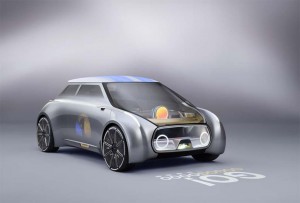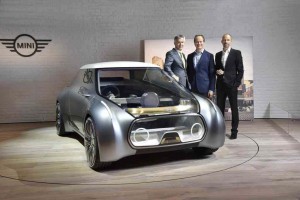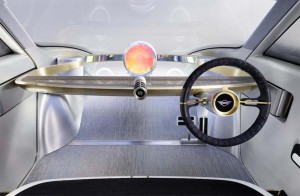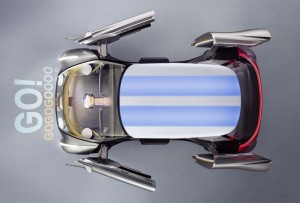Mini has made a specialty out of squeezing big things into little packages. But how might it take this “clever use of space” philosophy even further?
The British maker is offering up a hint in the form of the Mini Vision Next 100, one of three futuristic concept vehicles unveiled as part of the celebration of parent BMW’s 100th anniversary. The Mini prototype offers up some intriguing ways to enhance ingress and egress while also focusing on the connected car technologies that are rapidly becoming a part of mobile life.
With the Vision 100, “Mini looks to offer smart and bespoke mobility in cities that engages all the senses. And in the future, you might not actually have to own a vehicle to enjoy the benefits,” says Adrian van Hooydonk, the global director of BMW Group Design.
(BMW offers a look at its own Vision for the Next 100. Click Here to check it out.)
There are some familiar elements to the Vision concept. The basic shape is classic Mini two-box, but that’s about as far as it goes. From first glance, you know this isn’t your usual Mini.
Nose-on, the front end is almost entirely transparent. This all-electric concept offers open space where the engine compartment would normally be. That’s one of the big, potential advantages of electric propulsion, allowing even a small car like a Mini hatchback offer the interior space of something significantly larger. Now add the unusual, swing-out doors of the concept and it also becomes a lot easier for passengers to get in and out of both front and rear seats.
Meanwhile, there’s just a simple crossbar where there would normally be an instrument panel. In fact, there’s nothing there but the familiar, round Mini speedometer and a steering wheel that can slide from left to right, depending upon who’s driving, if anyone is driving at all.
(Codename: 103EX. This is definitely not your – rich – father’s Rolls-Royce. Click Here for a look.)
Instead of conventional gauges, or even the LED touchscreens that are becoming all but ubiquitous in today’s cars, the Mini Vision projects information ahead of you, seemingly onto the road itself. There are display screens, meanwhile, built into the outer door skins, taking Mini’s emphasis on customization to new extremes.
The theme, “digitally mine,” underscores the high-tech nature of the Mini Vision Net 100. It’s designed to readily switch between autonomous and conventional driving modes. You can send it off to find a parking spot on its own, then call it to pick you up when you’re ready to move on.
The maker’s other theme is “Every Mini is my Mini,” and the message is that car- and ride-sharing are the way of the future. “The Mini of the future will be available 24/7,” we’re told, “able to pick its driver up from their desired location in a fully automated way and will adapt itself to the driver’s individual tastes, interests and preferences. At the heart of this concept is fully connected digital intelligence.”
The Mini concept’s emphasis on sustainability isn’t limited to its battery drivetrain, by the way. The British maker is showcasing a variety of recycled and lightweight materials in the Vision Next 100, including aluminum, brass, cellulose and even basalt.
Today’s Mini has come a long way since the first model, penned by legendary designer Alec Issigonnis, rolled out in 1959. The Vision Next 100 concept suggests it could remain an innovative icon for years to come.
(VW planning to roll out at least 30 battery-cars for 2025. Click Here for the latest.)




